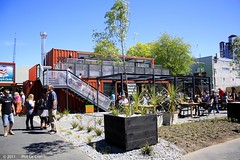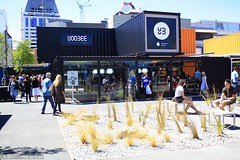Search
Images for Temporary; more images...
Elizabeth Ackermann Photograph 186
Images, UC QuakeStudies
A photograph of a desk and turn table taken during the Residential Access Project. The project gave residents temporary access within the red-zone cordon in order to retrieve items from their homes. The desk and turn table are covered in dust and rubble, and the outer wall is crumbled behind them.
Elizabeth Ackermann Photograph 216
Images, UC QuakeStudies
A photograph of workers from the Residential Access Project standing on High Street near the intersection with Tuam Street. In the background, a trailer is being loaded with items salvaged from people's homes during the project which gave residents temporary access to the cordon to retrieve items from their homes.
Elizabeth Ackermann Photograph 203
Images, UC QuakeStudies
A photograph of workers in fluorescent vests outside Alice in Videoland. The photograph was taken on 29 April 2011 during the Residential Access Project which gave residents temporary access within the red-zone cordon in order to retrieve items from their homes after the 22 February 2011 earthquake.
BeckerFraserPhotos December 2011 photograph 2374
Images, UC QuakeStudies
A photograph of a damaged building on Norwich Quay in Lyttelton. The temporary wooden wall at the front of the building has been painted to look like a Christmas present. A sign has been placed on the wall and reads, "All I want for Christmas is an answer from EQC!
Elizabeth Ackermann Photograph 192
Images, UC QuakeStudies
A photograph from inside a flat on Poplar Street taken during the Residential Access Project. The project gave residents temporary access within the red-zone cordon in order to retrieve items from their homes. A section of the wall has crumbled leaving the room exposed. A desk stands covered in dust and rubble.
Elizabeth Ackermann Photograph 200
Images, UC QuakeStudies
A photograph of Elizabeth Ackermann removing a poster from the kitchen of a flat on Poplar Street. This was part of the Residential Access Project which gave residents temporary access within the red-zone cordon in order to retrieve items from their homes after the 22 February 2011 earthquake.
BeckerFraserPhotos December 2011 photograph 0037
Images, UC QuakeStudies
A photograph of children standing on the plinth where the statue of John Robert Godley, Canterbury's founder, once stood. Members of the public are viewing the damaged cathedral from a walkway that was opened up between Re:Start Mall and Cathedral Square to allow temporary public access.
US Embassy Photograph 25
Images, UC QuakeStudies
Members of the USAID Disaster Assistance Response Team (DART) setting up a tent in Latimer Square after their early-morning arrival in Christchurch. Latimer Square was set up as a temporary headquarters for emergency management personnel after the 22 February 2011 earthquake.
WEMO ERT Set 1 - February 2011 - Photograph 56
Images, UC QuakeStudies
A photograph of a media briefing on the Christchurch earthquake response. The briefing was held in the in the Christchurch Art Gallery, which served as the temporary Civil Defence headquarters after the 22 February 2011 earthquake. Mayor Bob Parker is about to speak.
Elizabeth Ackermann Photograph 180
Images, UC QuakeStudies
A photograph of the site of a demolished building on Tuam Street which is being used as a car park. The photograph was taken during the Residential Access Project which gave residents temporary access within the red-zone cordon in order to retrieve items from their homes after the 22 February 2011 earthquake.
Elizabeth Ackermann Photograph 190
Images, UC QuakeStudies
A photograph from inside a flat on Poplar Street taken during the Residential Access Project. The project gave residents temporary access within the red-zone cordon in order to retrieve items from their homes. The majority of the wall has crumbled leaving the room exposed. A clothes horse and a monitor are covered in dust.
UC Civil and Natural Resources Engineering Photograph 211
Images, UC QuakeStudies
A photograph of a projector set up in the Avonhead Baptist Church. The room is to be used as a temporary lecture theatre for the Department of Civil and Natural Resources Engineering, as lecture theatres on campus are inaccessible following the 22 February 2011 earthquake.
Elizabeth Ackermann Photograph 201
Images, UC QuakeStudies
A photograph of trailers full of furniture and belongings from people's homes on Poplar Lane parked on High Street near the intersection with Tuam Street. The items were removed from the homes during the Residential Access Project which gave residents temporary access within the red-zone cordon in order to retrieve their possessions.
Elizabeth Ackermann Photograph 197
Images, UC QuakeStudies
A photograph of the inside of a fridge in a flat on Poplar Street taken during the Residential Access Project. The project gave residents temporary access within the red-zone cordon in order to retrieve items from their homes. The contents of the fridge have gone mouldy after being left in there for three weeks.
Elizabeth Ackermann Photograph 198
Images, UC QuakeStudies
A photograph of the inside of a fridge in a flat on Poplar Street taken during the Residential Access Project. The project gave residents temporary access within the red-zone cordon in order to retrieve items from their homes. The contents of the fridge have gone mouldy after being left in there for three weeks.
US Embassy Photograph 34
Images, UC QuakeStudies
Al Dwyer, leader of the USAID Disaster Assistance Response Team (DART), outside the US headquarters in Latimer Square. Members of DART can be seen behind him. Latimer Square was set up as a temporary headquarters for emergency management personnel after the 22 February 2011 earthquake.
Mark Lincoln Photograph 184
Images, UC QuakeStudies
A woman takes a photograph over the top of the cordon fence at the east end of Re:Start mall. The photographer comments, "The new temporary city mall has been open in Christchurch now for a week. Buildings damaged in the earthquake have been demolished and replaced with cargo containers to create a new, temporary, Cashel Mall. I visited the mall yesterday and was quite impressed with what they have done. The cargo containers have been nicely converted, brightly painted and smartly branded to create some good looking stores ... You'd think it would be strange to stand where my old office used to be and view these cargo-container-stores, but the reality was that it was so far removed from what used to be there that it was actually quite difficult to make the connection. It was only when straying to the attractive wooden boundary fences and peering over that you're suddenly taken back to the time running right up to, and shortly after, the earthquake".
Nisbet, Alistair, 1958- :Cardboard cathedral proposed... 3 August 2011
Images, Alexander Turnbull Library
The title is 'Cardboard cathedral proposed...' The cartoon shows the Christchurch Cathedral completed with cardboard boxes and a spire made of used toilet rolls. A puppy is in the process of unwinding toilet paper from the last roll. On an earlier part of the roof stand cardboard cutouts of the Christchurch wizard and maybe the mayor, Bob Parker. Context: A design for a temporary cathedral has been outlined by renowned Japanese architect Shigeru Ban. The proposed $4 million temporary replacement for Christchurch's destroyed cathedral made of shipping containers and cardboard has been met with scepticism from residents of the quake-hit city who wonder whether another church is really what the city needs right now. (3 News 1 August 2011) Quantity: 1 digital cartoon(s).
US Embassy Photograph 3
Images, UC QuakeStudies
Members of the USAID Disaster Assistance Response Team (DART) and the New Zealand Urban Search and Rescue Team conferring in a tent full of equipment in Latimer Square. Latimer Square was set up as a temporary headquarters for emergency management personnel after the 22 February 2011 earthquake.
20110307_2009_1D3-85 Liquefaction silt pile [EQNZ]
Images, eqnz.chch.2010
This is a temporary pile of silt piled on the old Bexley landfill sight. Some trucks are addng to the pile, while other truck and trailer units are taking it away to the old Bottle Lake landfill sight, a few km to the north of here.
Elizabeth Ackermann Photograph 185
Images, UC QuakeStudies
A photograph of a dusty monitor in an earthquake-damaged building on Poplar Street taken during the Residential Access Project. The Residential Access Project gave residents temporary access within the red-zone cordon in order to retrieve items from their homes after the 22 February 2011 earthquake. Dislodged bricks can also be seen around the monitor.
Elizabeth Ackermann Photograph 209
Images, UC QuakeStudies
A photograph of workers in fluorescent vests standing in front of the earthquake damaged McKenzie and Willis Building. The photograph was taken on 29 April 2011 during the Residential Access Project which gave residents temporary access within the red-zone cordon in order to retrieve items from their homes after the 22 February 2011 earthquake.
Elizabeth Ackermann Photograph 199
Images, UC QuakeStudies
A photograph of a carton of eggs inside the fridge of a flat on Poplar Street during the Residential Access Project. The project gave residents temporary access within the red-zone cordon in order to retrieve items from their homes. The contents of the fridge have gone mouldy after being left in there for three weeks.
Elizabeth Ackermann Photograph 245
Images, UC QuakeStudies
A photograph of a Christchurch City Council completed authorization form. This form was part of the Residential Access Project which gave residents temporary access within the red-zone cordon in order to retrieve items from their homes after the 22 February 2011 earthquake. Personal information has been removed from this photograph in order to protect the individual's privacy.
Elizabeth Ackermann Photograph 179
Images, UC QuakeStudies
A photograph of two workers standing in the site of a demolished building on Tuam Street which is being used as a car park. The photograph was taken during the Residential Access Project which gave residents temporary access within the red-zone cordon in order to retrieve items from their homes after the 22 February 2011 earthquake.
BeckerFraserPhotos July 2011 photograph 385
Images, UC QuakeStudies
A photograph captioned by BeckerFraserPhotos, "Avonside Girls High School sign". The sign reads, "This site is closed but the school is open. Avonside Girls High School has been temporarily relocated to Burnside High School, 151 Greers Road, Burnside 8053. Please do not enter this site - earthquake-damaged buildings".
US Embassy Photograph 37
Images, UC QuakeStudies
Prime Minister John Key preparing for a photograph with Al Dwyer, leader of the Disaster Assistance Response Team (DART), and members of DART, outside the US headquarters in Latimer Square. Latimer Square was set up as a temporary headquarters for emergency managements personnel after the 22 February 2011 earthquake.
US Embassy Photograph 36
Images, UC QuakeStudies
Prime Minister John Key preparing for a photograph with Al Dwyer, leader of the Disaster Assistance Response Team (DART), and members of DART, outside the US headquarters in Latimer Square. Latimer Square was set up as a temporary headquarters for emergency managements personnel after the 22 February 2011 earthquake.
Elizabeth Ackermann Photograph 202
Images, UC QuakeStudies
A photograph of an Urban Search and Rescue team member walking past workers from HireQuip outside Alice in Videoland. The photograph was taken on 29 April 2011 during the Residential Access Project which gave residents temporary access within the red-zone cordon in order to retrieve items from their homes after the 22 February 2011 earthquake.
Elizabeth Ackermann Photograph 177
Images, UC QuakeStudies
A photograph of Brandon, Elizabeth Ackerman and Danica Nel on the site of a demolished building on Tuam Street. The trio can be seen wearing hard hats and florescent vests. The photograph was taken during the Residential Access Project which gave residents temporary access within the red-zone cordon in order to retrieve items from their homes after the 22 February 2011 earthquake.



